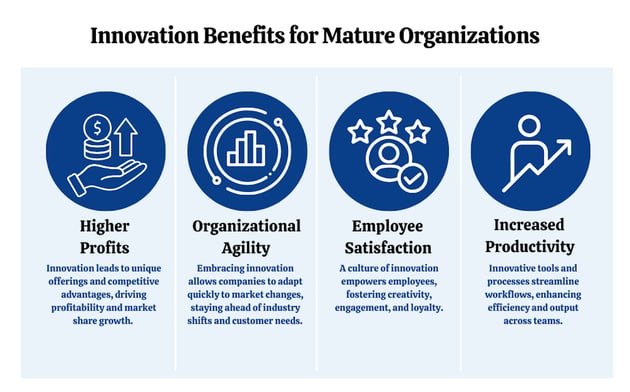Innovation in Mature Organizations: Strategies to Foster a Culture of Creativity and Growth
5/8/20244 min read


In a fast-evolving business environment, companies must continuously innovate to remain competitive. The benefits of innovation include high profit margins, agility, employee satisfaction, and productivity gains. Despite its recognized importance, the definition and practical implementation of innovation remain elusive. For the purpose of this article, I define innovation as “the process of making changes in something established, especially by introducing new methods, ideas, or products”.


Strategies for Fostering Innovation
1. Organizational Redesign
To reconcile stability with creativity, mature organizations can redesign their structure to support both administrative and entrepreneurial management:
Agile Teams: Implementing small, cross-functional teams that respond quickly to market changes.
Flattened Hierarchies: Simplifying organizational charts and reducing bureaucratic layers to enable faster decision-making.
These changes allow employees greater access to resources and reduce decision paralysis, particularly in large organizations.
2. Embedding Innovation in Organizational Culture
A culture of innovation relies on shared values that encourage risk-taking, collaboration, and experimentation. By updating core values and mission statements, organizations can signal the importance of innovation. Leaders should also align performance evaluations and career advancement with these new values to reinforce desired behaviors.
3. The Role of the Chief Innovation Officer (CIO)
Today, the CIO’s role goes beyond IT management to include fostering innovation and responding to market disruptions. Appointing a CIO highlights the C-suite’s commitment to innovation, encouraging employees to engage in transformative initiatives. Several advantages include higher revenues, improved customer satisfaction, and efficient product management.
4. Organizational Learning and Training
Robust learning programs foster innovation by equipping employees with the skills and knowledge needed for creative problem-solving. Many employees may express the desire to innovate but since few companies offer formal innovation training, employees lack understanding of the innovation process. To an average employee, the concept of innovation may seem arcane, chaotic, and unmethodical. Introducing people to popular innovation methodologies, such as Blue Ocean Strategy, Design Thinking, and Agile Thinking as well as various innovation types, such as product and process innovation, is crucial to enable employees to think creatively.
Promoting Internal Collaboration
Innovation is a collaborative process that requires diverse perspectives. However, generational differences and remote work preferences create challenges in building meaningful connections. Mature organizations can overcome these obstacles by implementing programs that promote intergenerational knowledge-sharing and collaboration.
5. Reverse Mentorship
Pairing senior leaders with younger employees in a reverse mentorship arrangement allows for mutual learning. Reverse mentoring requires pairing a senior executive with a younger associate, just like in a regular mentoring setting, with the difference that both participants mutually educate each other. For example, a Gen Z employee helps a senior colleague understand the nuances of how younger clients engage with social media to drive sales, and the senior executive educates the junior employee about the company’s strategy. Reverse mentorship also provides younger employees with the opportunity to feel valuable and have impact, thereby reducing turnover and attrition. For example, younger employees share insights on social media trends, while senior leaders offer strategic guidance. This approach enhances collaboration and gives younger employees a sense of purpose, reducing turnover.
6. Shadow Board
Another innovation lever organizations could pull on is the shadow board - a group of non-executive employees who work with senior executives on strategic initiatives, such as go-to-market strategy, marketing issues, or employee retention. The Board of Directors and the Shadow Board convene separately, discussing the same issues (e.g., thinning profit margins, new product development). When the Shadow Board reports to the Board of Directors, the insights and solutions often differ vastly. The Board then has a more comprehensive, well-rounded perspective on the issue at hand and can take a more innovative approach to problem-solving This setup provides fresh perspectives on issues, leading to innovative solutions that might not emerge within traditional leadership structures.
Building External Collaboration
7. External Partnerships
Ensuring collaboration externally with industry stakeholders is just as important as fostering collaboration internally between employees and across departments. Collaboration with external partners - whether competitors, suppliers, or research institutions brings in fresh ideas, complementary expertise, and valuable resources. Partnerships provide access to complementary expertise, specialized knowledge, important resources (e.g., hardware and software), and funding. Partnerships create a symbiotic relationship, in which organizations can draw upon each other’s knowledge and capabilities to drive product and process innovation. Inter-firm knowledge exchange in particular emerges as a critical innovation antecedent.
One of the most beneficial ways to drive innovation for a large and well-established company is to partner with a small-sized company or a startup that has the agility and special technical knowledge that a large company lacks. The startup receives access to valuable resources, such as funding. The result is often an innovative product or service that neither company could not have conceived on its own. Indeed, strategic partnerships produced some of the most innovative products:
Apple and Corning partnered to develop advanced glass technologies like the Ceramic Shield used on iPhones, enhancing durability and screen strength.
Pfizer and BioNTech collaborated to create the first widely distributed mRNA COVID-19 vaccine, achieving rapid development and global distribution to save lives..
Toyota and Aurora partnered to develop a self-driving car.
NASA and SpaceX teamed up to create the Falcon 9 rocket and Dragon spacecraft, enabling private missions to the ISS and advancing space travel.